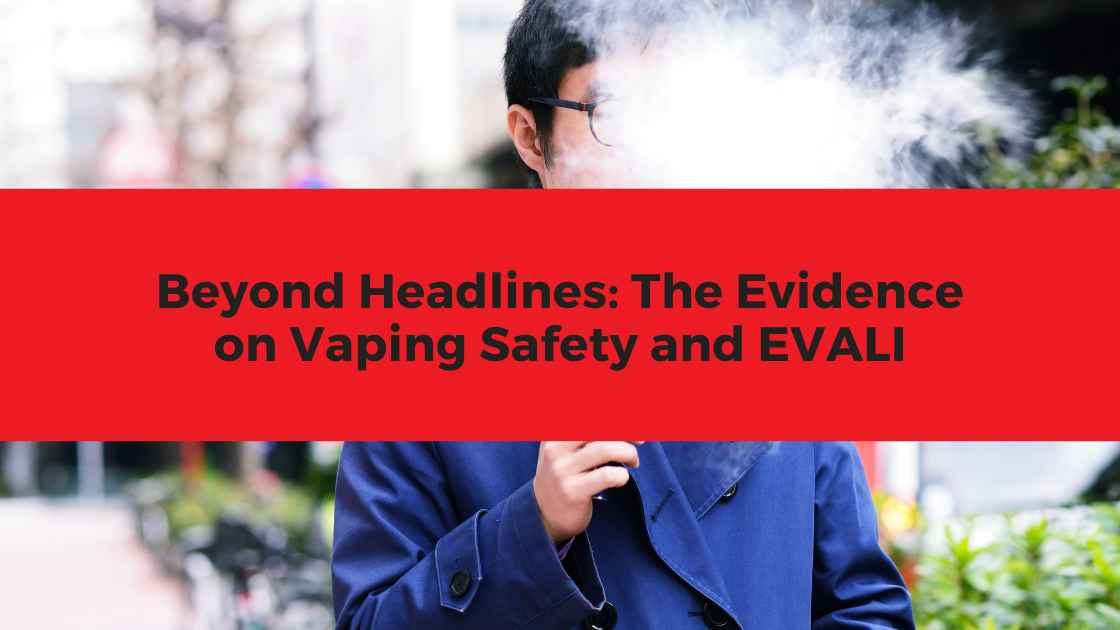Beyond Headlines: The Evidence on Vaping Safety and EVALI
Vaping has emerged as a popular alternative to traditional cigarettes, prompting intense debate about its health implications. With conflicting information circulating in media reports, it’s important to examine the evidence carefully, particularly regarding the 2019 EVALI outbreak (E-cigarette or Vaping Product Use-Associated Lung Injury) that raised significant concerns about vaping safety.
Vaping vs. Smoking: Understanding the Differences
Research suggests that while vaping carries health risks, health officials consider it to be less harmful than smoking traditional cigarettes.[1] This relative difference in harm stems primarily from the absence of tobacco combustion in vaping, which eliminates exposure to thousands of harmful chemicals produced when cigarettes burn.
The UK health bodies including NHS and US FDA acknowledge that vaping exposes users to fewer toxins than smoking—approximately 2,000 chemicals compared to 7,000 in cigarette smoke—and typically delivers less nicotine per puff.[2][3] Both bodies maintain that vaping is not safe, particularly for youth and pregnant women, but the scientific consensus points toward lower overall risk compared to combustible tobacco products.
Understanding EVALI: What Research Has Shown
The EVALI outbreak that peaked in 2019 caused significant concern, resulting in 2,758 hospitalised cases and 64 deaths by February 2020.[4] However, subsequent research has provided critical insights:
- Vitamin E acetate, an additive found in some THC-containing vaping products, was identified as the primary cause of EVALI. The CDC found this substance in the lung fluid of 48 out of 51 affected patients, but not in healthy individuals.[5]
- Approximately 78% of EVALI cases involved THC-containing products obtained from informal sources like friends or dealers, while only 16% involved exclusively nicotine vaping products.[4]
- Since regulatory actions targeted these specific products, EVALI cases have significantly declined, suggesting the outbreak was linked to specific contaminated products rather than vaping in general.[4]
Media Coverage: Limitations and Concerns
Some media reports have potentially overstated vaping risks by:
- Failing to distinguish between different vaping products: Not clearly differentiating between regulated nicotine vapes and illicit THC products linked to EVALI.
- Overgeneralising health risks: Linking vaping to numerous lung conditions like COPD and asthma without strong evidence, despite these conditions being more strongly associated with smoking.
- Using dramatic case examples without context: Highlighting severe cases from the EVALI outbreak without clarifying they were primarily linked to contaminated THC products, not typical nicotine vaping.
- Misinterpreting policy recommendations: Citing calls for flavour bans (aimed at reducing youth appeal) as evidence of equivalent danger to smoking, when these are distinct policy considerations.
Where We Stand Today
Current evidence suggests:
- Vaping is likely less harmful than smoking, though not risk-free
- EVALI was primarily associated with Vitamin E acetate in illicit THC products
- The outbreak has largely subsided following regulatory actions
- Long-term effects of vaping remain under study
For those trying to quit smoking, UK NHS and FDA-approved cessation methods remain the first-line recommendation. Those who choose to vape should obtain products only from reputable sources and avoid THC-containing vapes, particularly from informal markets.
References
[1] UK NHS ‘Vaping to quit smoking’ https://www.nhs.uk/better-health/quit-smoking/ready-to-quit-smoking/vaping-to-quit-smoking/
[2] CDC, “Health Effects of Vaping.” https://www.cdc.gov/tobacco/e-cigarettes/health-effects.html
[3] FDA, “E-Cigarettes, Vapes, and other Electronic Nicotine Delivery Systems (ENDS).” https://www.fda.gov/tobacco-products/products-ingredients-components/e-cigarettes-vapes-and-other-electronic-nicotine-delivery-systems-ends
[4] CDC, “Outbreak of Lung Injury Associated with the Use of E-Cigarette, or Vaping, Products.” https://archive.cdc.gov/www_cdc_gov/tobacco/basic_information/e-cigarettes/severe-lung-disease.html
[5] American Lung Association, “E-cigarette or Vaping Use-Associated Lung Injury (EVALI).” https://www.lung.org/lung-health-diseases/lung-disease-lookup/evali



Comments are closed here.